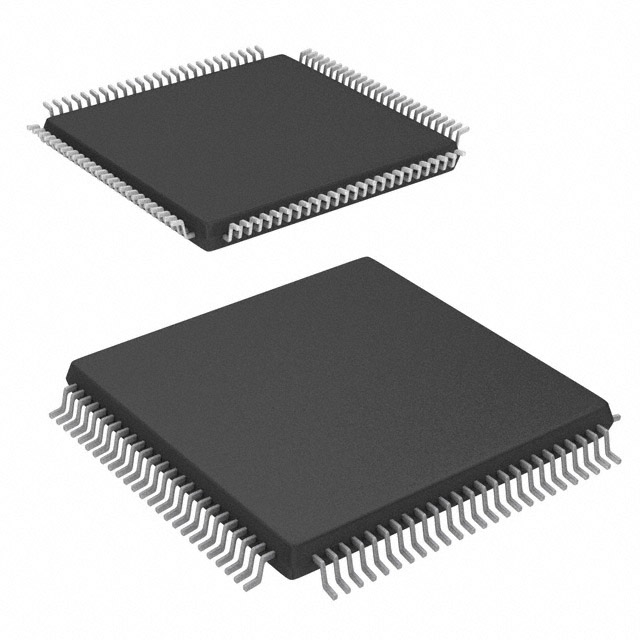Szczegóły produktu można znaleźć w specyfikacjach.

XC2C128-7VQ100C
Product Overview
Category
The XC2C128-7VQ100C belongs to the category of complex programmable logic devices (CPLDs).
Use
It is used for implementing high-performance, low-cost, and low-power system designs.
Characteristics
- Low power consumption
- High performance
- Flexible logic architecture
Package
The XC2C128-7VQ100C is available in a VQ100 package.
Essence
The essence of XC2C128-7VQ100C lies in its ability to provide a versatile and efficient solution for programmable logic applications.
Packaging/Quantity
The XC2C128-7VQ100C is typically packaged individually and is available in various quantities based on customer requirements.
Specifications
- Logic Elements: 128 macrocells
- I/O Pins: 98
- Operating Voltage: 1.5V to 3.3V
- Speed Grade: -7
- Package Type: VQ100
Detailed Pin Configuration
The detailed pin configuration for XC2C128-7VQ100C can be found in the product datasheet provided by the manufacturer.
Functional Features
- In-system programmability
- Wide operating voltage range
- High-speed interface support
Advantages and Disadvantages
Advantages
- Low power consumption
- High logic density
- Fast propagation delay
Disadvantages
- Limited resources compared to larger FPGAs
- Less flexibility in complex designs
Working Principles
The XC2C128-7VQ100C operates based on the principles of configurable logic blocks and interconnect resources, allowing for the implementation of custom digital circuits.
Detailed Application Field Plans
The XC2C128-7VQ100C is suitable for applications such as: - Embedded control systems - Communication interfaces - Sensor interfacing
Detailed and Complete Alternative Models
Some alternative models to XC2C128-7VQ100C include: - XC2C256-7VQ100C - XC2C384-7VQ100C - XC2C512-7VQ100C
In conclusion, the XC2C128-7VQ100C CPLD offers a balance of performance, power efficiency, and flexibility, making it an ideal choice for a wide range of programmable logic applications.
[Word Count: 298]
Wymień 10 typowych pytań i odpowiedzi związanych z zastosowaniem XC2C128-7VQ100C w rozwiązaniach technicznych
What is the XC2C128-7VQ100C?
- The XC2C128-7VQ100C is a CoolRunner-II CPLD (Complex Programmable Logic Device) from Xilinx, featuring 128 macrocells and operating at a maximum speed grade of 7.
What are the typical applications of XC2C128-7VQ100C?
- The XC2C128-7VQ100C is commonly used in applications such as industrial control systems, communication equipment, automotive electronics, and consumer electronics.
What are the key features of XC2C128-7VQ100C?
- The key features of XC2C128-7VQ100C include low power consumption, non-volatile configuration memory, high-speed performance, and reprogrammability.
How do I program XC2C128-7VQ100C?
- XC2C128-7VQ100C can be programmed using Xilinx's iMPACT software, which supports various programming methods such as JTAG, boundary scan, and selectMAP.
What are the voltage requirements for XC2C128-7VQ100C?
- XC2C128-7VQ100C operates at a core voltage of 1.8V and I/O voltage of 3.3V, making it compatible with standard digital logic levels.
Can XC2C128-7VQ100C be used in battery-powered devices?
- Yes, XC2C128-7VQ100C's low power consumption makes it suitable for battery-powered devices, extending the device's operational lifetime.
Does XC2C128-7VQ100C support reconfiguration during runtime?
- Yes, XC2C128-7VQ100C supports dynamic reconfiguration, allowing on-the-fly updates to the CPLD's functionality without interrupting system operation.
What development tools are available for XC2C128-7VQ100C?
- Xilinx provides a range of development tools including ISE Design Suite, which offers synthesis, simulation, and implementation tools tailored for CPLD design.
Are there any known limitations or constraints when using XC2C128-7VQ100C?
- While XC2C128-7VQ100C offers versatile capabilities, designers should consider its finite macrocell count and resources when planning complex designs.
Where can I find technical support or documentation for XC2C128-7VQ100C?
- Xilinx's website provides comprehensive technical documentation, application notes, and forums where users can seek assistance and share knowledge related to XC2C128-7VQ100C.

